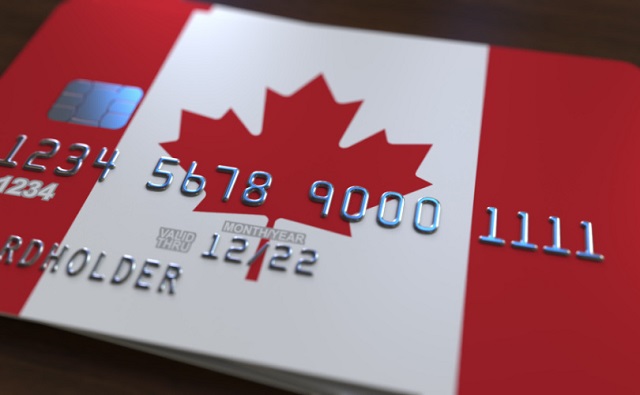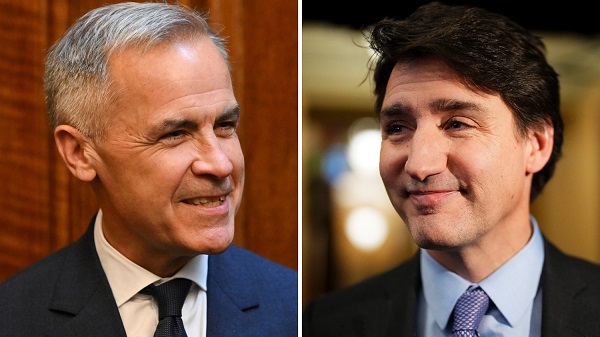Economy
Taxpayer watchdog slams Trudeau gov’t for increasing debt ceiling: ‘Put down the credit card’

From LifeSiteNews
Canadian Finance Minister Chrystia Freeland authorized an additional $73 billion in borrowing this fiscal year.
After Canadian Finance Minister Chrystia Freeland gave herself and the government the authority to borrow an additional $73 billion this fiscal year, the head of the nation’s leading taxpayer watchdog group said the federal government needs to “put down the credit card” and return to common-sense spending.
Freeland, as per a February 15 cabinet order made under the Financial Administration Act, allowed the extra borrowing to take place.
The government has set “$517 billion to be the maximum aggregate principal amount of money that may be borrowed” before April 1. Before this cabinet order, however, the maximum amount was $444 billion.
Despite Freeland claiming that the increase in borrowing is “in no way a blank cheque,” Canadian Taxpayers Federation federal director Franco Terrazzano said the borrowing needs to end.
“The Trudeau government needs to put down the credit card and pick up some scissors,” Terrazzano told LifeSiteNews.
“The government should be cutting spending and balancing the budget, not racking up more debt for years to come.”
In 2021, Canada’s Parliament raised the federal debt borrowing amount by a whopping 56% under the Borrowing Authority Act. The amount went from $1.168 trillion to $1.831 trillion.
“What it does is set a ceiling for how much the government can spend,” Freeland said at the time.
Terrazzano told LifeSiteNews that the Trudeau government should be cutting spending and balancing the budget, not racking up more debt for years to come.
“More debt means more money wasted on interest charges and less room to cut taxes,” he noted.
Terrazzano observed that in the coming year the Trudeau government will be spending “more money on debt interest charges than it sends to the provinces in health transfers.”
“In a handful of years, every penny collected from the GST (Goods and Service Tax) will go toward paying interest on the debt,” he noted.
Under Prime Minister Justin Trudeau, due to excessive COVID money printing, inflation has skyrocketed.
Last month, LifeSiteNews reported that fast-rising food costs in Canada have led to many people feeling a sense of “hopelessness and desperation” with nowhere to turn for help, according to the Canadian government’s own National Advisory Council on Poverty.
Last year, the Bank of Canada acknowledged that Trudeau’s federal “climate change” programs, which have been deemed “extreme” by some provincial leaders, are indeed helping to fuel inflation.
Terrazzano told LifeSiteNews that Trudeau should “completely scrap his carbon tax,” which is making everything more expensive.
Conservatives blast increased debt
Conservative Party of Canada (CPC) MPs have been critical of the raised debt ceiling. “You’re simply saying, ‘Give me a blank cheque and then trust me,’” MP Ed Fast said.
Freeland claimed that the “characterization of the borrowing authority limit as a blank cheque is simply false.”
CPC leader Pierre Poilievre recently asked, “Is there a dollar figure to which she would limit the debt?”
She replied that the government is “mindful that limits exist.”
During a February 13 Senate national finance committee meeting, Budget Officer Yves Giroux noted how Trudeau’s cabinet plans in terms of spending are not clear.
“We don’t know exactly what the government plans on spending or doing in terms of new spending or potential spending,” he said when asked by Senator Elizabeth Marshall if the new borrowing limits are “still realistic.”
Marshall added, “As it stands now, do you think it looks reasonable?”
“It looks sufficient, but the government always wants to give itself some room to maneuver in case there are unforeseen events that require borrowing on short notice,” Giroux replied.
A report from September 5, 2023, by Statistics Canada shows food prices are rising faster than headline inflation at a rate of between 10% and 18% per year.
According to a recent Statistics Canada survey of supermarket prices, Canadians are paying 12% more for carrots, 14% more for hamburger (ground meat), and 27% more for baby formula.
Business
Climate Climbdown: Sacrificing the Canadian Economy for Net-Zero Goals Others Are Abandoning

By Gwyn Morgan
Canada has spent the past decade pursuing climate policies that promised environmental transformation but delivered economic decline. Ottawa’s fixation on net-zero targets – first under Justin Trudeau and now under Prime Minister Mark Carney – has meant staggering public expenditures, resource project cancellations and rising energy costs, all while failing to
reduce the country’s dependence on fossil fuels. Now, as key international actors reassess the net-zero doctrine, Canada stands increasingly alone in imposing heavy burdens for negligible gains.
The Trudeau government launched its agenda in 2015 by signing the Paris Climate Agreement aimed at limiting the forecast increase in global average temperature to 1.5°C by the end of the century. It followed the next year with the Pan-Canadian Framework on Clean Growth and Climate Change that imposed more than 50 measures on the economy, key among them a
carbon “pricing” regime – Liberal-speak for taxes on every Canadian citizen and industry. Then came the 2030 Emissions Reduction Plan, committing Canada to cut greenhouse gas emissions to 40 percent below 2005 levels by 2030, and to achieve net-zero by 2050. And then the “On-Farm Climate Action Fund,” the “Green and Inclusive Community Buildings Program” and the “Green Municipal Fund.”
It’s a staggering list of nation-impoverishing subsidies, taxes and restrictions, made worse by regulatory measures that hammered the energy industry. The Trudeau government cancelled the fully-permitted Northern Gateway pipeline, killing more than $1 billion in private investment and stranding hundreds of billions of dollars’ worth of crude oil in the ground. The
Energy East project collapsed after Ottawa declined to challenge Quebec’s political obstruction, cutting off a route that could have supplied Atlantic refineries and European markets. Natural gas developers fared no better: 11 of 12 proposed liquefied natural gas export terminals were abandoned amid federal regulatory delays and policy uncertainty. Only a single LNG project in Kitimat, B.C., survived.
None of this has had the desired effect. Between Trudeau’s election in 2015 and 2023, fossil fuels’ share of Canada’s energy supply actually increased from 75 to 77 percent. As for saving the world, or even making some contribution towards doing so, Canada contributes just 1.5 percent of global GHG emissions. If our emissions went to zero tomorrow, the emissions
growth from China and India would make that up in just a few weeks.
And this green fixation has been massively expensive. Two newly released studies by the Fraser Institute found that Ottawa and the four biggest provinces have either spent or foregone a mind-numbing $158 billion to create just 68,000 “clean” jobs – an eye-watering cost of over $2.3 million per job “created”. At that, the green economy’s share of GDP crept up only 0.3
percentage points.
The rest of the world is waking up to this folly. A decade after the Paris Agreement, over 81 percent of the world’s energy still comes from fossil fuels. Environmental statistician and author Bjorn Lomborg points out that achieving global net-zero by 2050 would require removing the equivalent of the combined emissions of China and the United States in each of the next five
years. “This puts us in the realm of science fiction,” he wrote recently.
In July, the U.S. Department of Energy released a major assessment assembled by a team of highly credible climate scientists which asserted that “CO 2 -induced warming appears to be less damaging economically than commonly believed,” and that aggressive mitigation policies might be “more detrimental than beneficial.” The report found no evidence of rising frequency or severity of hurricanes, floods, droughts or tornadoes in U.S. historical data, while noting that U.S. emissions reductions would have “undetectably small impacts” on global temperatures in any case.
U.S. Energy Secretary Chris Wright welcomed the findings, noting that improving living standards depends on reliable, affordable energy. The same day, the Environmental Protection Agency proposed rescinding the 2009 “endangerment finding” that had designated CO₂ and other GHGs as “pollutants.” It had led to sweeping restrictions on oil and gas development and fuelled policies that the current administration estimates cost the U.S. economy at least US$1 trillion in lost growth.
Even long-time climate alarmists are backtracking. Ted Nordhaus, a prominent American critic, recently acknowledged that the dire global warming scenarios used by the Intergovernmental Panel on Climate Change rely on implausible combinations of rapid population growth, strong economic expansion and stagnant technology. Economic growth typically reduces population increases and accelerates technological improvement, he pointed out, meaning emissions trends will likely be lower than predicted. Even Bill Gates has tempered his outlook, writing that climate change will not be “cataclysmic,” and that although it will hurt the poor, “it will not be the only or even the biggest threat to their lives and welfare.” Poverty and disease pose far greater threats and resources, he wrote, should be focused where they can do the most good now.
Yet Ottawa remains unmoved. Prime Minister Carney’s latest budget raises industrial carbon taxes to as much as $170 per tonne by 2030, increasing the competitive disadvantage of Canadian industries in a time of weak productivity and declining investment. These taxes will not measurably alter global emissions, but they will deepen Canada’s economic malaise and
push production – and emissions – toward jurisdictions with more lax standards. As others retreat from net-zero delusions, Canada moves further offside global energy policy trends – extending our country’s sad decline.
The original, full-length version of this article was recently published in C2C Journal.
Gwyn Morgan is a retired business leader who has been a director of five global corporations.
Carbon Tax
Carney fails to undo Trudeau’s devastating energy policies

From the Fraser Institute
By Tegan Hill and Elmira Aliakbari
On the campaign trail and after he became prime minister, Mark Carney has repeatedly promised to make Canada an “energy superpower.” But, as evidenced by its first budget, the Carney government has simply reaffirmed the failed plans of the past decade and embraced the damaging energy policies of the Trudeau government.
First, consider the Trudeau government’s policy legacy. There’s Bill C-69 (the “no pipelines act”), the new electricity regulations (which aim to phase out natural gas as a power source starting this year), Bill C-48 (which bans large oil tankers off British Columbia’s northern coast and limit Canadian exports to international markets), the cap on emissions only from the oil and gas sector (even though greenhouse gas emissions have the same effect on the environment regardless of the source), stricter regulations for methane emissions (again, impacting the oil and gas sector), and numerous “net-zero” policies.
According to a recent analysis, fully implementing these measures under Trudeau government’s emissions reduction plan would result in 164,000 job losses and shrink Canada’s economic output by 6.2 per cent by the end of the decade compared to a scenario where we don’t have these policies in effect. For Canadian workers, this will mean losing $6,700 (annually, on average) by 2030.
Unfortunately, the Carney government’s budget offers no retreat from these damaging policies. While Carney scrapped the consumer carbon tax, he plans to “strengthen” the carbon tax on industrial emitters and the cost will be passed along to everyday Canadians—so the carbon tax will still cost you, it just won’t be visible.
There’s also been a lot of buzz over the possible removal of the oil and gas emissions cap. But to be clear, the budget reads: “Effective carbon markets, enhanced oil and gas methane regulations, and the deployment at scale of technologies such as carbon capture and storage would create the circumstances whereby the oil and gas emissions cap would no longer be required as it would have marginal value in reducing emissions.” Put simply, the cap remains in place, and based on the budget, the government has no real plans to remove it.
Again, the cap singles out one source (the oil and gas sector) of carbon emissions, even when reducing emissions in other sectors may come at a lower cost. For example, suppose it costs $100 to reduce a tonne of emissions from the oil and gas sector, but in another sector, it costs only $25 a tonne. Why force emissions reductions in a single sector that may come at a higher cost? An emission is an emission regardless of were it comes from. Moreover, like all these policies, the cap will likely shrink the Canadian economy. According to a 2024 Deloitte study, from 2030 to 2040, the cap will shrink the Canadian economy (measured by inflation-adjusted GDP) by $280 billion, and result in lower wages, job losses and a decline in tax revenue.
At the same time, the Carney government plans to continue to throw money at a range of “green” spending and tax initiatives. But since 2014, the combined spending and forgone revenue (due to tax credits, etc.) by Ottawa and provincial governments in Ontario, Quebec, British Columbia and Alberta totals at least $158 billion to promote the so-called “green economy.” Yet despite this massive spending, the green sector’s contribution to Canada’s economy has barely changed, from 3.1 per cent of Canada’s economic output in 2014 to 3.6 per cent in 2023.
In his first budget, Prime Minister Carney largely stuck to the Trudeau government playbook on energy and climate policy. Ottawa will continue to funnel taxpayer dollars to the “green economy” while restricting the oil and gas sector and hamstringing Canada’s economic potential. So much for becoming an energy superpower.
-

 Alberta1 day ago
Alberta1 day agoAlberta Offers Enormous Advantages for AI Data Centres
-

 Daily Caller17 hours ago
Daily Caller17 hours ago‘Holy Sh*t!’: Podcaster Aghast As Charlie Kirk’s Security Leader Reads Texts He Allegedly Sent University Police
-

 Alberta1 day ago
Alberta1 day agoNational Crisis Approaching Due To The Carney Government’s Centrally Planned Green Economy
-

 Alberta1 day ago
Alberta1 day agoCalgary mayor should retain ‘blanket rezoning’ for sake of Calgarian families
-

 Great Reset17 hours ago
Great Reset17 hours agoCanadian government forcing doctors to promote euthanasia to patients: report
-

 Carbon Tax9 hours ago
Carbon Tax9 hours agoCarney fails to undo Trudeau’s devastating energy policies
-

 Alberta17 hours ago
Alberta17 hours agoSylvan Lake football coach fired for opposing transgender ideology elected to town council
-

 Agriculture17 hours ago
Agriculture17 hours agoFederal cabinet calls for Canadian bank used primarily by white farmers to be more diverse




